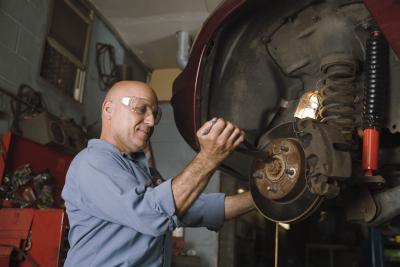
Saab is a Swedish company that made aircraft years before the first automobile was rolling off its assembly lines. The first Saab car available to the public was introduced in 1949. The Saab 9-3 first appeared in 1998 and is still in production as of 2010. The Saab 9-3, like all Saabs made from Day One, come standard with front wheel drive and disc brakes. When the brake pads wear thin on your Saab 9-3, they must be replaced to ensure you have full stopping power when you need it.
Loosen the lug nuts on all four wheels. Raise you Saab 9-3 with a hydraulic jack and place jack stands under each corner of the car’s frame. Lower the hydraulic jack until your Saab’s weight is resting on the jack stands. Remove the lug nuts on all four wheels with a lug wrench. Remove the wheels from the wheel hubs and set them aside.
Locate the caliper holding pins on the front face of the brake caliper. Drive the pins out from front to back, using a punch and a hammer. Make sure the diameter of the punch is slightly smaller than the diameter of the pins. Drive the pins out until they fall out of the backside of the caliper.
Pull the brake pads (there will be two per wheel, one on each side of the brake rotor) and the sheet metal spring straight up from the top of the caliper. Discard them.
Compress the piston back into the caliper so that the new, thicker brake pads will fit into the caliper. Do this by angling a flat-blade screwdriver into the caliper, making sure the end of the screwdriver is against the piston. Lever the screwdriver, using the brake rotor as a fulcrum, and push the piston back into the caliper.
Slide the new brake pads into place, making sure the holes in the flange of the pads line up with the holes in the caliper for the holding pins. Push one of the holding pins in from the backside of the caliper. Hammer the pin in until it is fully seated.
Angle the hook of a new brake spring under the pin already installed. Slide the remaining pin into place, making sure it is in the correct position over the other hook in the spring. Hammer the pin in from the backside of the caliper until it is fully seated.
Repeat the above procedure for installing pads on the remaining calipers. Place the wheels back on the wheel hubs and tighten the lug nuts in a clockwise direction until hand tight. Raise the car with the hydraulic jack and remove the jack stands. Lower the car to the ground with the hydraulic jack, then tighten the lug nuts securely with the lug wrench.